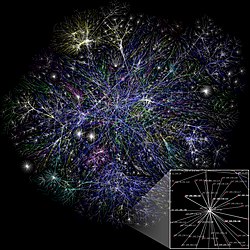Portal:Internet
The Internet PortalThe Internet (or internet) is the global system of interconnected computer networks that uses the Internet protocol suite (TCP/IP) to communicate between networks and devices. It is a network of networks that consists of private, public, academic, business, and government networks of local to global scope, linked by a broad array of electronic, wireless, and optical networking technologies. The Internet carries a vast range of information resources and services, such as the interlinked hypertext documents and applications of the World Wide Web (WWW), electronic mail, internet telephony, and file sharing. The origins of the Internet date back to research that enabled the time-sharing of computer resources, the development of packet switching in the 1960s and the design of computer networks for data communication. The set of rules (communication protocols) to enable internetworking on the Internet arose from research and development commissioned in the 1970s by the Defense Advanced Research Projects Agency (DARPA) of the United States Department of Defense in collaboration with universities and researchers across the United States and in the United Kingdom and France. The ARPANET initially served as a backbone for the interconnection of regional academic and military networks in the United States to enable resource sharing. The funding of the National Science Foundation Network as a new backbone in the 1980s, as well as private funding for other commercial extensions, encouraged worldwide participation in the development of new networking technologies and the merger of many networks using DARPA's Internet protocol suite. The linking of commercial networks and enterprises by the early 1990s, as well as the advent of the World Wide Web, marked the beginning of the transition to the modern Internet, and generated sustained exponential growth as generations of institutional, personal, and mobile computers were connected to the internetwork. Although the Internet was widely used by academia in the 1980s, the subsequent commercialization of the Internet in the 1990s and beyond incorporated its services and technologies into virtually every aspect of modern life. (Full article...) Selected article Norid AS is the registry for the Norwegian country-code top-level domains (ccTLDs) .no (Norway), .sj (Svalbard and Jan Mayen) and .bv (Bouvet Island). By agreement with the Internet Assigned Numbers Authority, Norid is delegated the exclusive authority to assign, administer and register domain names under these three top-level domains. Of these three top-level domains, second-level domains may only be registered under .no, while use of .sj and .bv is presently reserved. (Full article...) Selected pictureA portmanteau of emotion (or emote) and icon, an emoticon is a symbol or combination of symbols used to convey emotional content in written or message form. Ralph Breaks the Internet is a 2018 American animated comedy film produced by Walt Disney Animation Studios. It is the sequel to the 2012 film Wreck-It Ralph. The film was directed by Rich Moore and Phil Johnston from a screenplay by Johnston and Pamela Ribon. John C. Reilly, Sarah Silverman, Jack McBrayer, Jane Lynch, and Ed O'Neill reprise their character roles from the first film, with Gal Gadot, Taraji P. Henson, Alfred Molina and Alan Tudyk joining the cast. In the film, Ralph and Vanellope von Schweetz must travel to the internet to get a replacement for the Sugar Rush cabinet's broken steering wheel and prevent Mr. Litwak from disposing of the game. Discussions about a sequel to Wreck-It Ralph began in September 2012, and the new installment went through three different scripts before the filmmakers settled on the final plot. When the film was officially announced in June 2016, most of the original cast confirmed they had signed on, with new cast members added in 2018. The film's title of Ralph Breaks the Internet was announced in March 2017. Ralph Breaks the Internet premiered in Hollywood, Los Angeles, on November 5, 2018, and was released in the United States on November 21. The film received generally positive reviews from critics and was a commercial success, grossing $529 million worldwide against a $175 million budget. It was nominated for Best Animated Feature at the 91st Academy Awards, 76th Golden Globe Awards, 46th Annie Awards, and 24th Critics' Choice Awards. (Full article...) WikiProjects
Did you know (auto-generated) -
Selected biography
Douglas C. Engelbart (born January 30, 1925 in Oregon) is an American inventor of Swedish and Norwegian descent. As a World War II naval radio technician based in the Philippines, Engelbart was inspired by Vannevar Bush's article "As We May Think". Engelbart received a Bachelor's degree in electrical engineering from Oregon State University in 1948, a B.Eng. from UC Berkeley in 1952, and a Ph.D. in EECS from UC Berkeley in 1955. At Stanford Research Institute , Engelbart was the primary force behind the design and development of the On-Line System, or NLS. He and his team at the Augmentation Research Center developed computer-interface elements such as bit-mapped screens, groupware, hypertext and precursors to the graphical user interface. In 1967, Engelbart applied for and later received a patent for the wooden shell with two metal wheels (computer mouse). Engelbart later revealed that it was nicknamed the "mouse" because the tail came out the end. He would also work on the ARPANET, the precursor of the Internet. In later years he moved to the private firm Tymshare after SRI was transferred to the company. McDonnell Douglas took over the copany in 1982, and in 1986 he left the company. As of 2007, he is the director of his own company, the Bootstrap Institute, which founded in 1988 and located in Fremont, California.
General images -The following are images from various internet-related articles on Wikipedia.
Selected quoteMain topics
Featured contentCategoriesRelated portalsThings you can do
Associated WikimediaThe following Wikimedia Foundation sister projects provide more on this subject:
Wikipedia's portals |





















































